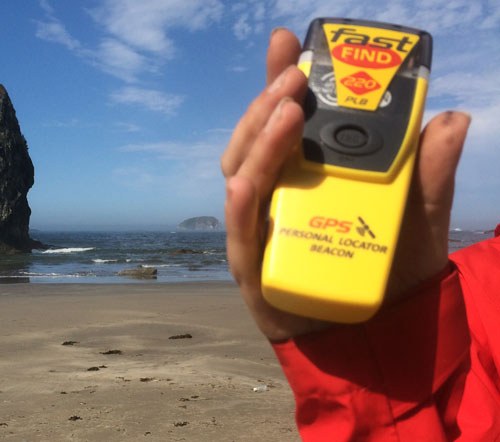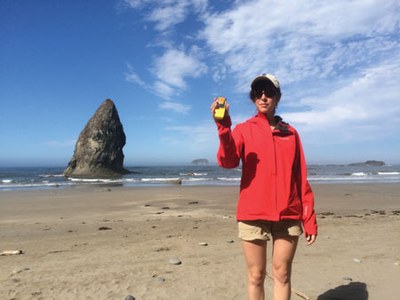
by Dick Lambe, Mountaineers trip leader
It’s a climber’s nightmare. Last February both members of a 2-party climbing team fell and slid 800’ descending Mt. Stuart, sustaining serious injuries, including head and neck injuries and a broken leg. Yet, within less than four hours they are rescued by helicopter. How did they notify the rescue agency? A satellite notification device.
Seattle Mountaineer Gene Yore (co-author of Guide to 100 Peaks at Mount Rainier National Park) was solo scrambling Double Peak in Mount Rainier National Park in June 2014. During his descent, he slipped and broke his fibula and could no longer travel. He activated his SPOT satellite messenger about 7 am, and the rescue helicopter appeared about 2 pm. Search and Rescue personnel assisted him to a spot the helicopter could land, where he was evacuated.
Seattle Mountaineer Climb Leader Harlan Brown broke his ankle on a Mt. Daniel climb in August 2014. He activated his SPOT satellite notification device. Within 3 hours, a Snohomish County Helicopter Rescue Team helicopter was hovering overhead. Soon afterward, he arrived at Everett’s Providence Hospital.
Others who did not carry a satellite notification device might have benefited.
Just over 10 years ago, in July 2005, three Tacoma Mountaineers died while attempting to evacuate an injured climber from Shark Fin Tower. While satellite notification devices became legal to use in Washington State in 2003, they were not widely used in 2005. If the Shark Fin Tower party had carried one, the climbers could have signaled for help and a helicopter rescue might have avoided the need to attempt the difficult and ultimately fatal evacuation.
Two types of satellite notification devices exist: Personal Locator Beacons (PLB) like the ACR ResQLink and Satellite Emergency Notification Devices (SEND) like the SPOT or DeLorme inReach. Each has strengths and weaknesses.
PLBs are single purpose devices – just for sending emergency rescue signals. They use the government COSPAS-SARSAT satellite system. Once activated in the U.S., a signal travels by satellite to the Air Force Rescue Coordination Center, which notifies the appropriate rescue agency, which notifies the county, which coordinates the rescue. This signal includes your identity and location. PLBs also transmit a signal which the rescuer can use to home-in on your location.
SEND devices are more versatile. Both SPOT and inReach send emergency rescue messages, but also can send “OK” status messages to your designated recipients or limited text messages. The inReach can also receive text messages. Both SPOT and inReach send messages by satellite to the privately-run GEOS International Emergency Response Coordination Center. Assuming you are current in payment on your subscription, this Center relays emergency rescue messages to the local rescue authorities. SPOT uses the private Globalstar satellite network with global coverage, except polar regions and sub-Sahara Africa. InReach uses the private Iridium satellite network, with global coverage.
For sending emergency rescue signals (SOS), PLBs are much more reliable. Besides using the more reliable government satellite system, they transmit a 5 watt signal, while inReach’s signal is 1.6 watts and SPOT’s is 0.4 watts. A review by Outdoorgearlab says a PLB is “far superior” to a SEND device for sending a SOS signal. Similarly, REI, which sells both SEND and PLB devices says: “While a handy tool for casual hikers and backpackers, satellite messengers [SEND devices] transmit signals that are much less powerful than a PLB signal. They are not intended for serious mountaineering use.”
Another option is a satellite phone. While more flexible than either a PLB or SEND, it is more expensive and also relies on the less effective private satellite systems used by SEND devices. If you have a signal, a cell phone is usually the best option, but many backcountry areas of Washington lack cell phone coverage.
None of these devices are infallible. Particularly for SEND devices, if your emergency contact person is expecting regular “OK” messages, that fallibility might be a source of stress or cause them to initiate a rescue. Tacoma Mountaineer Sharon Carlson experienced that very problem on a Mt. Stuart climb she led in July 2014. Her SPOT device failed to send numerous “OK” messages to her emergency contact, resulting in the contact person calling Search and Rescue.
PLBs cost about $280 to buy. SPOTs cost about $150, though frequently discounted. InReachs cost between $300 and $400, though Mountaineer Leaders may be eligible for a 25% discount under the Promotive program.
PLBs are much cheaper to use: they have no subscription fee, though the 5 year battery costs about $150 to replace. Both SPOT and inReach charge annual subscription fees ranging from $100 to $960 per year, depending on the features selected. PLBs and SPOTs weigh less than inReach: 4 to 5 ounces versus about 7.
Perhaps the ideal solution is to have both a PLB and a SEND device (or a satellite phone) in the group; this gives you the advantage of the greater reliability of the PLB for SOS messages, and the greater flexibility of the SEND device.
I have a PLB. I carry it on most backcountry outings to areas without reliable cell phone coverage. I have informally polled people on some Mountaineers’ trips, and it seems less than 25% carry either PLB or SEND devices.

Should you carry a PLB or SEND device?
Besides helping you (or a companion) get rescued, a satellite notification device helps rescuers, by making rescues faster and safer. As explained in a post-rescue e-mail from Randy King, Mount Rainier National Park Superintendent, to Gene Yore:
“The fact that you had a SPOT device helped immensely in getting to you quickly and in preventing an extensive search that would have posed inherent risk to many more responders. Thanks for being prepared!”
 Richard Lambe
Richard Lambe